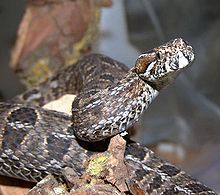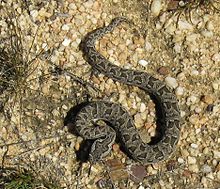- Bitis atropos
-
Bitis atropos 
Scientific classification Kingdom: Animalia Phylum: Chordata Subphylum: Vertebrata Class: Reptilia Order: Squamata Suborder: Serpentes Family: Viperidae Subfamily: Viperinae Genus: Bitis Species: B. atropos Binomial name Bitis atropos
(Linnaeus, 1758)Synonyms - Coluber atropos - Linnaeus, 1754
- [Coluber] Atropos - Linnaeus, 1758
- Cobra Atropos - Laurenti, 1768
- Vipera Atropos - Sonnini & Latreille, 1801
- [Vipera (Echidna)] Atropos - Merrem, 1820
- Vipera montana - A. Smith, 1826
- [Echidna] Atropos - Wagler, 1830
- Clotho [(Bitis)] Atropos - Gray, 1842
- E[chidna]. ocellata - Tschudi, 1845
- Calechidna ocellata - Tschudi, 1845
- Edchidna atropos - Duméril, Bibron & Duméril, 1854
- Bitis atropos - Günther, 1858
- V[ipera]. (Echidna) atropos - Jan, 1863
- Bitis atropos - Boulenger, 1893
- [Bitis atropos] atropos - FitzSimons, 1959
- Bitis atropos unicolor - FitzSimons, 1959
- Bitis atropos atropos - Broadley, 1962
- Bitis atropos - Carpenter & Furguson, 1977
- Bitis atropos - Broadley, 1983
- Viper atropos - Golay et al., 1993
- Bitis atropos - Golay et al., 1993[1]
Bitis atropos is a venomous viper species found only in mountainous regions in southern Africa.[1] A small species. No subspecies are currently recognized.[5]
Contents
Description
The average adult size is 30–40 cm, with some females reaching a maximum 50 cm in the wild and 60 cm in captivity.
Geographic range
The species is found in isolated populations of the mountainous regions of southern Africa.[1] In South Africa, the species is known to occur in the Transvaal, along the Drakensberg escarpment of the eastern and northern Transvaal. Elsewhere in South Africa, it occurs in western Natal, Lesotho and eastern Free State, and in the southern coastal mountains of western and eastern Cape Province.[1] Spawls & Branch (1995) also mention that in Cape Province, its range extends into the Cape Peninsula.[2][6] It also occurs in Swaziland, in higher altitudes of eastern Zimbabwe like the Inyanga Highlands and Chimanimani Mountains and in nearby Mozambique.[7]
The type locality given is "America", but this is obviously a mistake. More likely is the Cape of Good Hope, according to FitzSimons (1962).[1]
Habitat
Occupies a number of different habitats, but prefers relatively cool environments with high levels of precipitation. In the northern part of its range, where the winters are cold and dry and the summers warm and wet, it is therefore restricted to higher elevations, up to 3000 m. In Zimbabwe, it is not found below 1500 m. Usually associated with mountain slopes and rocky hillsides, but also montane grassland with patches of bushes and shrubs.[2][3]
In the southern part of its range (Cape Province, South Africa), where the winters are cold and wet and the summers warm and dry, it can be found in coastal and mountain heathland as well as small rock outcrops at sea level and grassy areas with clumps of bushes and shrubs west of the Cape Peninsula.[2][3][8]
Food and venom
The Berg adder is unusual among Bitis species, in that its venom is predominantly neurotoxic,[2] so much so that effects of the bite seldom include necrosis or infection. The snake is described as "irascible", hissing violently and twisting convulsively if molested.[9]
Presumably the neurotoxic venom is an adaptation to the prey, which largely comprise rock lizards and small amphibians. It does however also eat other animals such as small rodents and young of ground-nesting birds. The venom is not powerful enough for the dose injected at a single strike to kill an adult human, and there do not seem to be any records of human fatalities. However, whether at threat or not, patients do not seem to respond usefully to antivenin, so treatment should be limited to symptomatic control. Such as the effects of the venom are, they take effect quickly. Symptoms of the bite have been compared to alcohol intoxication and are not permanent. Unlike the bites of elapid snakes, Bitis atropos bites, though neurotoxic, do not cause obvious effects on heart and respiratory functions. However, they can be troublesome and their effects sometimes persist for some days or even weeks, which suggests that the venom causes nerve damage that does not mend quickly if it is severe. Obvious symptoms may include loss of smell or taste, drooping eyelids and loss of vision.[10]
See also
- List of viperine species and subspecies
- Viperinae by common name
- Viperinae by taxonomic synonyms
- Snakebite
References
- ^ a b c d e McDiarmid RW, Campbell JA, Touré T. 1999. Snake Species of the World: A Taxonomic and Geographic Reference, vol. 1. Herpetologists' League. 511 pp. ISBN 1-893777-00-6 (series). ISBN 1-893777-01-4 (volume).
- ^ a b c d e Spawls S, Branch B. 1995. The Dangerous Snakes of Africa. Ralph Curtis Books. Dubai: Oriental Press. 192 pp. ISBN 0-88359-029-8.
- ^ a b c Mallow D, Ludwig D, Nilson G. 2003. True Vipers: Natural History and Toxinology of Old World Vipers. Krieger Publishing Company, Malabar, Florida. 359 pp. ISBN 0-89464-877-2.
- ^ Bitis atropos at the Reptarium.cz Reptile Database. Accessed 2 August 2007.
- ^ "Bitis atropos". Integrated Taxonomic Information System. http://www.itis.gov/servlet/SingleRpt/SingleRpt?search_topic=TSN&search_value=634950. Retrieved 24 July 2006.
- ^ Berg adder (Bitis atropos)
- ^ G.V. Haagner, J. Hurter (1988). "Additional Distribution Records of the Berg Adder Bitis atropos in the South-eastern Transvaal and Swaziland". African Protected Area Conservation and Science 31 (1). http://www.koedoe.co.za/index.php/koedoe/article/view/485/496.
- ^ Berg adder (Bitis atropos)
- ^ Rose, Walter; The reptiles and Amphibians of Southern Africa; Pub; Maskew Miller 1950
- ^ Branch, Bill; Field Guide to the Snakes & other Reptiles of Southern Africa; Struik,1988
Further reading
- Broadley DG, Cock EV. 1975. Snakes of Rhodesia. Zimbabwe: Longman Zimbabwe Ltd. 97 pp.
- Broadley DG. 1990. FitzSimons' Snakes of Southern Africa. Parklands (South Africa): J Ball & AD Donker Publishers. 387 pp.
- FitzSimons VFM. 1962. Snakes of Southern Africa. Purnell and Sons (S.A.) (Pty.) LTD., Cape Town: Johannesburg. 423 pp.
- FitzSimons VFM. 1980. A Field Guide to the Snakes of Southern Africa. London: Collins Publishers 221 pp.
- Bitis atropos at Eco Travel Africa. Accessed 27 October 2011.
Categories:- Viperinae
- Reptiles of Africa
Wikimedia Foundation. 2010.


